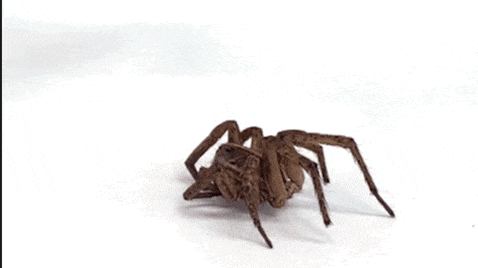If you think spiders are creepy when they’re alive, just wait until you see what they can do when they’re dead. A team of engineers at Rice University in Texas successfully reanimated dead spiders to serve as mechanical grippers.
That’s right. In proof that we have permanently strayed from God’s light, the team published a study of their Frankensteinian experiment in Advanced Science on July 26, in which they were able to control a dead spider’s legs with puffs of air. The authors described the creation as “necrobotics,” and believe that it could be used for a range of purposes including capturing insects and even assembling microelectronics.
“Prior research has focused on bioinspired systems, where researchers look to nature for inspiration and mimic the physical traits of living organisms in engineered systems,” Faye Yap, a mechanical engineer at Rice and lead author of the paper, told The Daily Beast in an email. She later added, “Necrobotics, on the other hand, uses biotic materials, which are non-living materials derived from once-living organisms, such as the necrobotic gripper sourced from a spider in our work.”
The team was inspired to create their hair-raising creation after they stumbled upon a dead spider moving things around their lab one day. After noticing how it curled when it died, they discovered that spider legs don’t have muscles like humans do, but instead rely on hydraulic pressure to move their limbs.
“We understand that many people are put off by the sight of a spider, but from an engineering point of view, the spider’s mechanism of movement is very interesting,” Yap said. “It definitely warrants taking a closer look at these creatures, and learning more from them.”
The team decided to see if they could actually control the legs. The mechanism was pretty straightforward: Yap inserted a syringe into a dead wolf spider’s internal hydraulic chamber and added some superglue to hold it in place. Then she added a small amount of air and the spider’s legs instantly opened. Voila! You have the world’s most cursed grabber tool.

The Rice University engineers used a small amount of air pressure to turn deceased spiders into necrobotic grippers.
Preston Innovation Laboratory/Rice UniversityWhile skin crawling, the necrobotic grabbers were highly effective at picking things up. The wolf spiders used in the experiment are capable of lifting more than 130 percent of their own body weight—which meant the zombified grippers wereable to grip objects much heavier than themselves.
The team also found that their new tool was surprisingly durable too. One spider was even able to sustain 1,000 open-close cycles before showing signs of wear and tear. But Yap said that they eventually “plan on incorporating thin polymeric coating materials to prolong the lifetime of the necrobotic gripper.”
Daniel Preston, an assistant professor of mechanical engineering at Rice and co-author of the paper, told The Daily Beast that, while the experiment has raised a few eyebrows, the general public “has been supportive.”

A gripper is used to lift a jumper and break a circuit on an electronic breadboard, turning off an LED.
Brandon Martin/Rice University“[The] typical reaction is a brief period of surprise, then an ‘a-ha’ moment where the underlying mechanism and engineering contributions of our work become apparent,” Preston said. “We hope this research will spark new ideas for how we can respectfully and sustainably source and utilize biotic materials for robotics applications.”
Preston added that the team hopes to eventually test the concept on smaller spiders, which can carry an even heavier load relative to its body weight and mass. The spider grabbers could also be used to catch other creepy-crawlies as well.
“Because the necrobotic gripper has inherent compliance and camouflaging capabilities, we envision that we can deploy it in scientific fieldwork,” Yap said. “For example, to capture and collect small insects and other live specimens without damaging them.”
Listen, this is no doubt creepy and pulled straight from the depths of our nightmares. But the necrobots do have a lot of useful applications. If you take a step back from the horror factor, it’s pretty cool in a pulpy sci-fi way. Let’s just hope they stick to spiders, though… and not something bigger.






